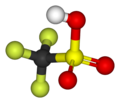Trifluoromethanesulfonic acid
 |
|||
|
|
|||
| Names | |||
|---|---|---|---|
|
IUPAC name
Trifluoromethanesulfonic acid
|
|||
| Other names
Triflic acid
|
|||
| Identifiers | |||
|
1493-13-6 |
|||
| 3D model (Jmol) | Interactive image | ||
| ChEBI |
CHEBI:48511 |
||
| ChemSpider |
56192 |
||
| ECHA InfoCard | 100.014.625 | ||
| PubChem | 62406 | ||
|
|||
|
|||
| Properties | |||
| CF3SO3H | |||
| Molar mass | 150.08 g/mol | ||
| Appearance | Colorless liquid | ||
| Density | 1.696 g/mL | ||
| Melting point | −40 °C (−40 °F; 233 K) | ||
| Boiling point | 162 °C (324 °F; 435 K) | ||
| Miscible | |||
| Acidity (pKa) | -14.7 (±2.0) | ||
| Hazards | |||
| Main hazards | Corrosive, eye irritant | ||
|
Except where otherwise noted, data are given for materials in their standard state (at 25 °C [77 °F], 100 kPa).
|
|||
|
|
|||
| Infobox references | |||
Trifluoromethanesulfonic acid, also known as triflic acid, TFMS, TFSA, HOTf or TfOH, is a sulfonic acid with the chemical formula CF3SO3H. It is one of the strongest acids. Triflic acid is mainly used in research as a catalyst for esterification. It is a hygroscopic, colorless, slightly viscous liquid and is soluble in polar solvents.
Trifluoromethanesulfonic acid is produced industrially by electrochemical fluorination (ECF) of methanesulfonic acid:
The resulting CF3SO2F is hydrolyzed, and the resulting triflate salt is preprotonated. Alternatively, trifluoromethanesulfonic acid arises by oxidation of trifluoromethylsulfenyl chloride:
Triflic acid is purified by distillation from triflic anhydride.
Trifluoromethanesulfonic acid was first synthesized in 1954 by Haszeldine and Kidd by the following reaction:
In the laboratory, triflic acid is useful in protonations because the conjugate base of triflic acid is nonnucleophilic. It is also used as an acidic titrant in nonaqueous acid-base titration because it behaves as a strong acid in many solvents (acetonitrile, acetic acid, etc.) where common mineral acids (such as HCl or H2SO4) are only moderately strong.
With a Ka = 5 × 1014, pKa −14.7 (±2.0), triflic acid qualifies as a superacid. It owes many of its useful properties to its great thermal and chemical stability. Both the acid and its conjugate base CF3SO−
3, known as triflate, resist oxidation/reduction reactions, whereas many strong acids are oxidizing, e.g. perchloric or nitric acid. Further recommending its use, triflic acid does not sulfonate substrates, which can be a problem with sulfuric acid, fluorosulfuric acid, and chlorosulfonic acid. Below is a prototypical sulfonation, which HOTf does not undergo:
...
Wikipedia


